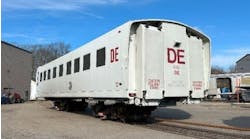Viridity Energy announced the achievement of a significant milestone in realizing the full potential of a technology solution that will enable the Southeastern Pennsylvania Transportation Authority (SEPTA) to capture the kinetic energy created from the regenerative braking ability of trains and trolleys at a high-use propulsion substation in Philadelphia and recycle that energy for redeployment into the electric grid. At this point in the installation process, the energy generated through the braking of the trains is now actually captured and stored through an energy storage system. This achievement puts SEPTA trains on the path toward becoming virtual power generators that can serve as an active electric grid resource that is equivalent to generation.
When SEPTA’s trains brake at each stop to load and unload thousands of Pennsylvania passengers, the kinetic energy of the train is converted into electricity. On the Market-Frankford and Broad Street lines there is no methodology in place to capture and deploy that excess energy at a later time. After SEPTA and Viridity Energy conducted an analysis of feasible energy storage technologies, a partnership was launched to conduct a pilot program to capture the regenerative braking energy of trains along the Market-Frankford line (the highest ridership in the SEPTA system) through a large-scale battery.
Through Viridity Energy’s VPower software optimization system and other partner technologies, this energy is being stored, reused, and ultimately will be deployed as a virtual generator into PJM’s wholesale power frequency regulation and energy markets.
“We are excited about the potential that this program has for SEPTA to achieve significant savings and revenue by capturing the energy created through the operations of their existing trains and leveraging that energy to meet the needs of the electric grid,” said Audrey Zibelman, president and CEO of Viridity Energy. “This project showcases that there is incredible opportunity on the customer side of the meter to transform existing assets into virtual power using smart energy technology. I congratulate SEPTA on leading the country in exploring the potential of storage technology to provide smart energy solutions that will benefit all electric consumers.”
“This project will bolster SEPTA’s ongoing efforts to control costs by making the transit system more sustainable,” SEPTA General Manager Joseph M. Casey said. “Through this pilot project, we are exploring a new resource that could provide savings and environmental benefits now and for generations to come.”
The project, funded in part through a 2010 Pennsylvania Energy Development Authority (PEDA) grant program, reached a significant milestone this week in achieving the integration of the energy storage assets, and demonstrating the collective ability to detect and capture regenerative braking energy. This represents a major step forward towards project completion. Through this project, SEPTA will capture and productively use electric power that would otherwise be wasted; generate significant new revenues through electric market participation; increase operational efficiency; support the achievement of sustainability goals; and enhance the reliability of the electric grid.
After a competitive bid process, an energy storage system from Saft and a system integration technology from Envitech Energy, a member of the ABB group, were selected to join the project and help to achieve SEPTA’s ambitious smart energy goals. Saft performed the design, manufacturing and commissioning of its Intensium Max20 P System, a battery energy storage system (ESS). Envitech Energy was selected to provide power controls, power conversion and system integration using its Envistoretm System.
“Saft supplied the first multiple purpose trackside energy storage system in North America – a fully integrated, containerized Li-ion solution – from our dedicated Jacksonville, Fla. facility. Our flexible lithium-ion technology provides both the energy and the power that is essential to such a demanding application,” said Blake Frye, vice president of sales, Energy Storage for Saft America. “We are very pleased by the results achieved by SEPTA and Viridity, thus far, and we are especially excited by the far-reaching implications of this pilot project in reducing energy costs for mass transit operators with commercially viable energy storage.”
“Using our Envistore system, we've successfully demonstrated our unique technical expertise in power conversion and real time controls applied to rail transport systems,” said Chris Poynter, vice-president Discrete Automation and Motion at ABB Inc. “Our solution enables SEPTA and Viridity to recover and recycle efficiently the otherwise lost surplus energy.”
Through this pilot, Viridity Energy will enable the participation of SEPTA in PJM’s frequency regulation market, which requires response to a 2 to 4 second PJM signal to provide a small injection or removal of power into the grid to ensure the grid operates at a frequency of 60 Hz. SEPTA will also be able to participate in PJM’s economic market, which is a high frequency, voluntary response program. Viridity Energy is one of the first “demand-side” participants in PJM’s regulation market.
Over the next month, the SEPTA pilot team will conduct a full-scale demonstration of regenerative capture and reuse, including regulation performance testing. Finally, the project will enable the simultaneous process of regenerative capture, regulation performance, and energy market participation utilizing Viridity Energy’s VPower optimizer to select which market to participate in based upon market pricing, battery state of charge, and availability of regenerative energy from the trains.




